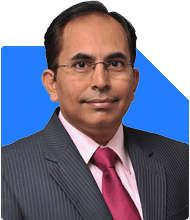Ramalingam Kalirajan |10893 Answers |Ask -Follow
Mutual Funds, Financial Planning Expert - Answered on May 04, 2024
He has an MBA in finance from the University of Madras and is a certified financial planner.
He is the director and chief financial planner at Holistic Investment, a Chennai-based firm that offers financial planning and wealth management advice.... more

Sir I have investing right now Parag Parikh flexi cap 2k,Nifty Total Market Index Fund 2k,ICICI Prudential Multi Cap Fund 1K,Nippon India Small Cap 1k,Tata Digital fund 500.Request your advice am I right in track for investing MF.
Parag Parikh Flexi Cap: This fund offers diversification across market segments and has a flexible investment approach. It's a good choice for long-term growth potential.
Nifty Total Market Index Fund: Investing in an index fund provides broad market exposure and low expense ratios. It's suitable for passive investors seeking market returns.
ICICI Prudential Multi Cap Fund: This fund invests across large, mid, and small-cap stocks, providing diversification and potential for higher returns. It complements your portfolio well.
Nippon India Small Cap: Small-cap funds have the potential for high growth but come with higher volatility. Ensure you're comfortable with the risk associated with this fund.
Tata Digital Fund: Investing in thematic funds like digital funds can offer exposure to high-growth sectors. However, they tend to be more volatile and may not suit all investors.
Overall, your portfolio seems well-diversified across market segments and investment styles. However, it's essential to regularly review your investments, monitor fund performance, and adjust your portfolio as needed based on changes in your financial goals and market conditions.
Consider consulting with a Certified Financial Planner for personalized advice tailored to your specific needs and goals. They can help ensure that your investment strategy aligns with your long-term financial objectives and risk tolerance.
You may like to see similar questions and answers below
Ramalingam Kalirajan |10893 Answers |Ask -Follow
Mutual Funds, Financial Planning Expert - Answered on Apr 05, 2024
Ramalingam Kalirajan |10893 Answers |Ask -Follow
Mutual Funds, Financial Planning Expert - Answered on Apr 04, 2024
Ramalingam Kalirajan |10893 Answers |Ask -Follow
Mutual Funds, Financial Planning Expert - Answered on May 26, 2024
Ramalingam Kalirajan |10893 Answers |Ask -Follow
Mutual Funds, Financial Planning Expert - Answered on Mar 06, 2025
Janak Patel |71 Answers |Ask -Follow
MF, PF Expert - Answered on Mar 06, 2025
Ramalingam Kalirajan |10893 Answers |Ask -Follow
Mutual Funds, Financial Planning Expert - Answered on Apr 03, 2025
Ramalingam Kalirajan |10893 Answers |Ask -Follow
Mutual Funds, Financial Planning Expert - Answered on Dec 15, 2025
Ramalingam Kalirajan |10893 Answers |Ask -Follow
Mutual Funds, Financial Planning Expert - Answered on Dec 15, 2025
Radheshyam Zanwar |6746 Answers |Ask -Follow
MHT-CET, IIT-JEE, NEET-UG Expert - Answered on Dec 15, 2025
Ramalingam Kalirajan |10893 Answers |Ask -Follow
Mutual Funds, Financial Planning Expert - Answered on Dec 15, 2025
Ramalingam Kalirajan |10893 Answers |Ask -Follow
Mutual Funds, Financial Planning Expert - Answered on Dec 15, 2025
Ramalingam Kalirajan |10893 Answers |Ask -Follow
Mutual Funds, Financial Planning Expert - Answered on Dec 15, 2025
Samraat Jadhav |2508 Answers |Ask -Follow
Stock Market Expert - Answered on Dec 15, 2025
Ramalingam Kalirajan |10893 Answers |Ask -Follow
Mutual Funds, Financial Planning Expert - Answered on Dec 15, 2025
Reetika Sharma |425 Answers |Ask -Follow
Financial Planner, MF and Insurance Expert - Answered on Dec 15, 2025
Radheshyam Zanwar |6746 Answers |Ask -Follow
MHT-CET, IIT-JEE, NEET-UG Expert - Answered on Dec 15, 2025
























